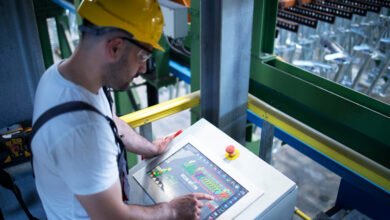How Mechanical Keyboard Switches Work

Mechanical switches on a keyboard provide users with more tactile feedback, a recognizable clicky sound, and a more comprehensive range of personal customization than membrane keyboards offer. Mechanical keyboards have been gaining popularity in recent years due to their satisfying tactile feedback, durability, and customizable features. However, many people are unaware of the complex mechanisms that lie behind these keyboards, specifically the mechanical switches that make them unique. However, knowing what kind of switch to choose can be challenging without interacting with them. This is especially true if you’re new to keyboards and mechanical switches.
The Stem
The stem is part of a mechanical keyboard switch that slides up and down when a key is pressed. It’s also the piece that mates the switch to the printed circuit board (PCB) in a keyboard. The structure of the stem determines the overall feel of a mechanical keyboard switch. The shape and thickness of the stem affect the pre-travel distance, total travel distance, actuation point, and tactile force, among other things. In addition to the stem, switches often feature rails that help a key actuate and bottom out. These rails can have additional rubber pads that stick out towards the top and bottom of them to dampen the sound when a key is pressed.
There are many different types of switches, each with its unique properties and characteristics. Some popular brands include Cherry MX, Kailh, Gateron, Outemu, and Romer-G. These switches are known for their durability, comfort, and customizability. A mechanical switch consists of several components: a base, a spring, a stem, and two metal contacts. When the user presses the key, the stem pushes down the spring, which then makes contact with the metal contacts and sends a signal to the computer. The spring then pushes the stem back up, resetting the switch for the next keypress.
The Spring
The spring is a critical component of any mechanical keyboard switch. It allows the key to actuate but adds or subtracts tactility, improves responsiveness, and reduces typing fatigue. The spring can be made from various materials, including metals and plastics. Steel is the most common material used and is generally inexpensive and available in a wide range of thicknesses. One of the most critical aspects of springs is weighting. This refers to how much force the spring needs to cut out or actuate the switch. Spring weights can vary significantly across pre-built switches and even aftermarket offerings, so it’s worth checking out a few samples before making a purchase.
Gold-plated springs are a popular option, as they’re resistant to corrosion and offer a more luxurious feel. However, they’re more expensive than standard springs and are often incompatible with certain switches. The sound of a mechanical switch is generated by the metal contacts inside the switch. As the switch is pressed, the metal contacts come into contact with each other and create an electrical circuit. This circuit sends a signal to the computer, registering the keypress. The sound of the switch is generated by the metal contacts snapping together, creating a satisfying clicking sound.
The Contacts
The Contacts of a mechanical keyboard switch are the tiny metal or gold pieces where electricity flows when the key is pressed down. When they contact the PCB, they establish an electrical circuit that registers a key press and closes that circuit. When typing on a laptop keyboard, you will notice a slight bump in resistance when you push down on a key. This is called the actuation point, which tells you when the key has been registered. Depending on how hard you press down the key, this will cause an electrical signal to be sent to the PCB that indicates a key press has been made. This is measured in centinewtons (cN) or gram-forces (gf).
There are three basic types of switches, Linear, Tactile, and Clicky. Each type has its actuation type, travel distance, and lifespan. Mechanical switches and rubber dome switches is the type of spring used. Rubber dome switches use a flexible rubber dome that collapses when the key is pressed, while mechanical switches use a coiled spring that provides resistance to the user’s keypress. This resistance, known as actuation force, is a key factor in determining the feel and sound of a mechanical switch.
The Keycaps
The keycaps are a significant part of a mechanical keyboard’s design. They come in various styles, including black, red, brown, and blue, each with its feel and sound. Choosing the right keycap for your typing experience is vital. You want to select the switch that will provide the most accurate feedback while letting you type quickly. An excellent way to determine which switches are best for you is to compare the operating force or force required to activate a switch. Switches with lower operating forces will be more responsive to input than switches with higher operating forces. You also need to consider the size and layout of your keyboard. Most mechanical keyboards use Cherry MX-style switches, but some companies make their proprietary switches.
You can also buy O-rings to shorten the keycap travel distance and reduce the noise from your keys. O-rings are usually 0.4mm thick and are compatible with Cherry MX switches. Mechanical switches come in various types, each with its own unique actuation force, sound, and feel. The most common types of mechanical switches are linear, tactile, and clicky. Linear switches have a smooth and consistent keypress, with no noticeable bump or click. Tactile switches have a noticeable bump or tactile feedback that lets the user know the key has been pressed, but no audible click. Clicky switches have both a tactile bump and an audible click, which provides satisfying and audible feedback when typing.
Conclusion
Mechanical switches are the backbone of mechanical keyboards, providing the satisfying tactile feedback, durability, and customizable features that make these keyboards so popular. Understanding the components and mechanisms of a mechanical switch, as well as the different types of switches available, is key to unlocking the full potential of these keyboards. Whether you are a competitive gamer, a typist, or just someone who enjoys the feel of a well-made keyboard, a mechanical keyboard with mechanical switches is a great investment for anyone who spends a lot of time typing.
Also Read Interesting Articles At: Zuhair Articles.




